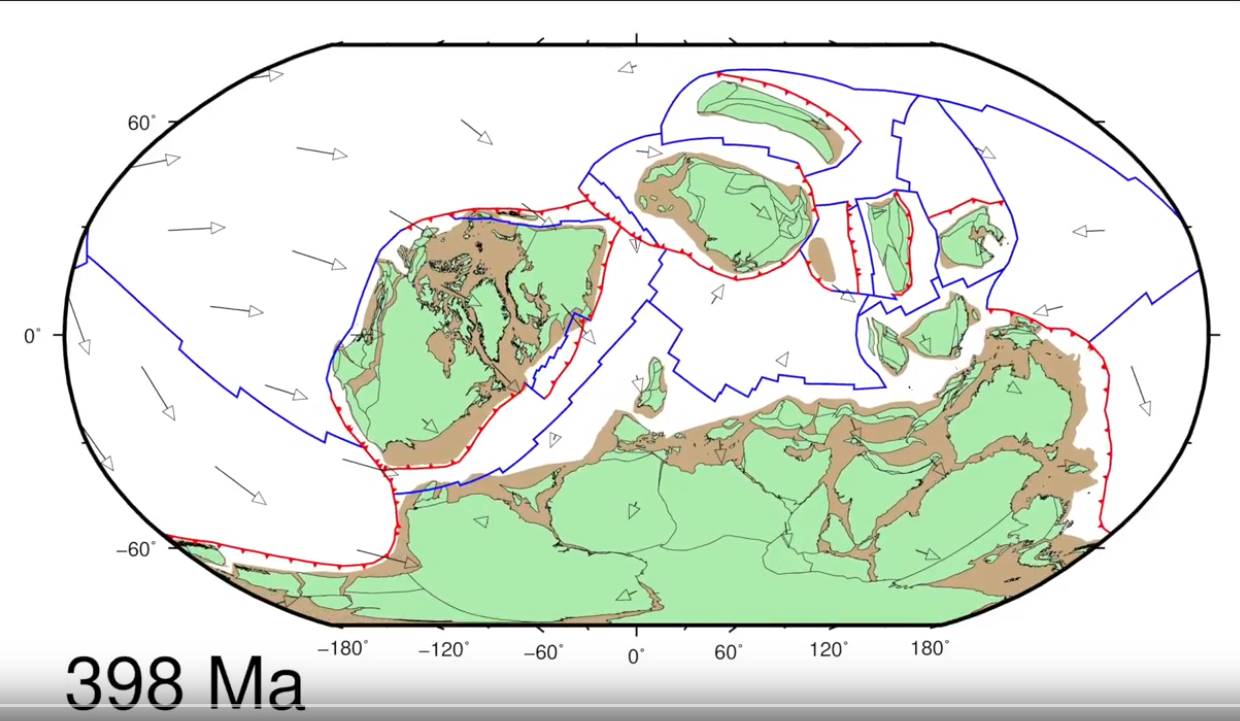Abstract: Detailed global plate motion models that provide a continuous description of plate boundaries through time are an effective tool for exploring processes both at and below the Earth’s surface. A new generation of numerical models of mantle dynamics pre- and post-Pangea timeframes requires global kinematic descriptions with full plate reconstructions extending into the Paleozoic (410 Ma). Current plate models that cover Paleozoic times are characterised by large plate speeds and trench migration rates because they assume that lowermost mantle structures are rigid and fixed through time. When used as a surface boundary constraint in geodynamic models, these plate reconstructions do not accurately reproduce the present-day structure of the lowermost mantle. Building upon previous work, we present a global plate motion model with continuously closing plate boundaries ranging from the early Devonian at 410 Ma to present day.
Detailed global plate motion models that provide a continuous description of plate boundaries through time are an effective tool for exploring processes both at and below the Earth’s surface. A new generation of numerical models of mantle dynamics pre- and post-Pangea timeframes requires global kinematic descriptions with full plate reconstructions extending into the Paleozoic (410 Ma). Current plate models that cover Paleozoic times are characterised by large plate speeds and trench migration rates because they assume that lowermost mantle structures are rigid and fixed through time. When used as a surface boundary constraint in geodynamic models, these plate reconstructions do not accurately reproduce the present-day structure of the lowermost mantle. Building upon previous work, we present a global plate motion model with continuously closing plate boundaries ranging from the early Devonian at 410 Ma to present day.
We analyse the model in terms of surface kinematics and predicted lower mantle structure. The magnitude of global plate speeds has been greatly reduced in our reconstruction by modifying the evolution of the synthetic Panthalassa oceanic plates, implementing a Paleozoic reference frame independent of any geodynamic assumptions, and implementing revised models for the Paleozoic evolution of North and South China and the closure of the Rheic Ocean. Paleozoic (410-250 Ma) RMS plate speeds are on average ~8 cm/yr, which is comparable to Mesozoic-Cenozoic rates of ~6 cm/yr on average. Paleozoic global median values of trench migration trend from higher speeds (~2.5 cm/yr) in the late Devonian to rates closer to 0 cm/yr at the end of the Permian (~250 Ma), and during the Mesozoic-Cenozoic (250-0 Ma) generally cluster tightly around ~1.1 cm/yr. Plate motions are best constrained over the past 130 Myr and calculations of global trench convergence rates over this period indicate median rates range between 3.2-12.4 cm/yr with a present day median rate estimated at ~5 cm/yr. For Paleozoic times (410-251 Ma) our model results in median convergence rates largely ~5 cm/yr. Globally, ~90% of subduction zones modelled in our reconstruction are determined to be in a convergent regime for the period 120-0 Ma. Over the full span of the model, from 410-0 Ma, ~93% of subduction zones are calculated to be convergent, and at least 85% of subduction zones are converging for 97% of modelled times. Our changes improve global plate and trench kinematics since the late Paleozoic and our reconstructions of the lowermost mantle structure challenge the proposed fixity of lower mantle structures, suggesting that the eastern margin of the African LLSVP margin has moved by as much as ~1450 km since late Permian times (260 Ma). The model of the plate-mantle system we present suggests that during the Permian Period, South China was proximal to the eastern margin of the African LLSVP and not the western margin of the Pacific LLSVP as previously thought.
Animation:
The link to the supplement can be found here:
![]()

